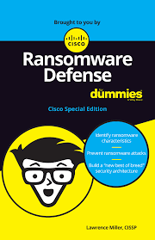It happens more often than you think. You're clicking through an email and begin downloading a file when all of a sudden, a red window pops up saying that all of your files have been encrypted! Unfortunately, this means that you've downloaded some ransomware and a hacker is now demanding payment to give you back your information. In a matter of seconds, your normal, productive day at work has become a business nightmare.
What is Ransomware?
Ransomware is a downloadable virus that holds your files hostage and unless you pay, you'll lose your information forever. An average ransom demand can range from hundreds of dollars for a small business to millions for enterprises, and these numbers can keep growing as hackers get better. Ransomware has become a top cyber threat for business as a whole, which means all companies, from startup to multinational, can't afford to ignore it.
Arm yourself with knowledge to understand how ransomware works and how you can protect your business from it.
How Ransomware Works
There are multiple ways in which a hacker can deliver ransomware. The most common way is through links in malicious emails or on the web that trigger an automatic download of malware into your network. Bolstering your email security and web security can help prevent this. Ransomware is designed to take advantage of all the vulnerabilities in your software and spread through your entire system in no time.
Cisco's recent Cybersecurity Report states all the vulnerabilities in your network that can be of higher risk where malware can enter. When it comes to cybersecurity it's important to know that 62% of malware infections come through internet browsers your employees use all the time. The other 38% exploit standard software, such as Adobe Flash Player and Java.
Regardless of the way of entry, once ransomware is in your system, your files will become inaccessible until you pay.
Never Pay the Criminals
More often than not, companies give in and pay the ransom. Although it seems like the easiest solution, you should never do this. Once a hacker/criminal has your information, paying their ransom is never a guarantee you'll get your information back. Some criminals will take your money and still destroy your data, leaving you with nothing.
Paying a ransom also helps the criminals develop more sophisticated malware that can become an even bigger threat to your company and others in the future.
The point is, there are technologies you can leverage to protect your business from ransomware attacks. You can determine where to begin buffing security by asking the following simple questions:
- Are you using a firewall and/or is it on at all times? Firewalls will stop malicious software from accessing your network, but you must have it working at all times.
- How often do you backup your data? Having a backup of your information in an online service or data center guarantees access to your information in the event of data downtime. Dropbox for business and Microsoft 365 are great tools that can help you achieve this.
- What antivirus program do you have? There are many free antivirus programs, but it can risky to use them as they may not be trustworthy. It is well worth the money to use a top of the line antivirus program to protect your data.
- Have you installed ad-blocking software? In the Cisco CyberSecurity Report, you can learn more about malvertising and how it operates. Having ad-blocking software will reduce the likelihood of any of this to access your network.
Be prepared for the worst-case scenario
Right now, you might not have everything in place to prevent ransomware attacks, so what should you do if ransomware does get into your network?
First, try to stay calm and don't pay the hackers. As we mentioned before, paying will not guarantee you'll get your information back. Then, shut down all the devices in your network and run a full scan. If you have a backup of your information, the safest thing to do is to wipe all your devices and reinstall your data.
It will take time and you may lose some data, but at least you'll be able to control the situation. If you need assistance on understanding the core components of a cybersecurity strategy you can always refer to an IT specialist for support.
Download Guide: Ransomware Defense for Dummies
Want to learn more on how to build your cybersecurity defense?
Cisco's Ransomware Defense for Dummies: an easy guide to building a security architecture and strategy to protect your business against ransomware attacks.
If you have any questions let us know, we are here to help you.







